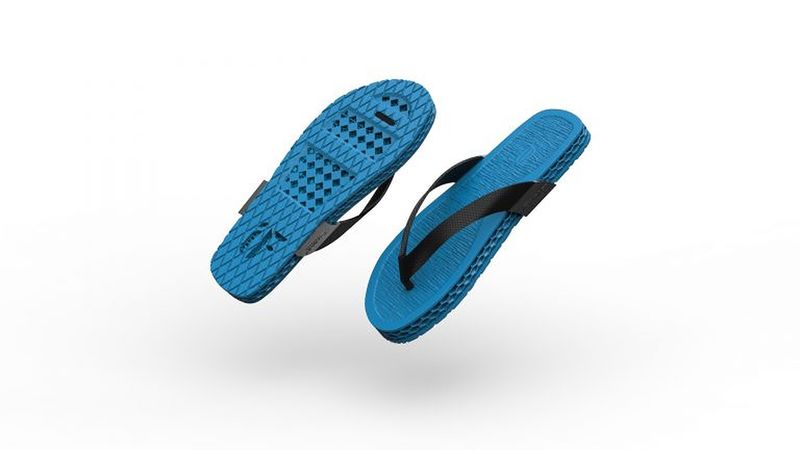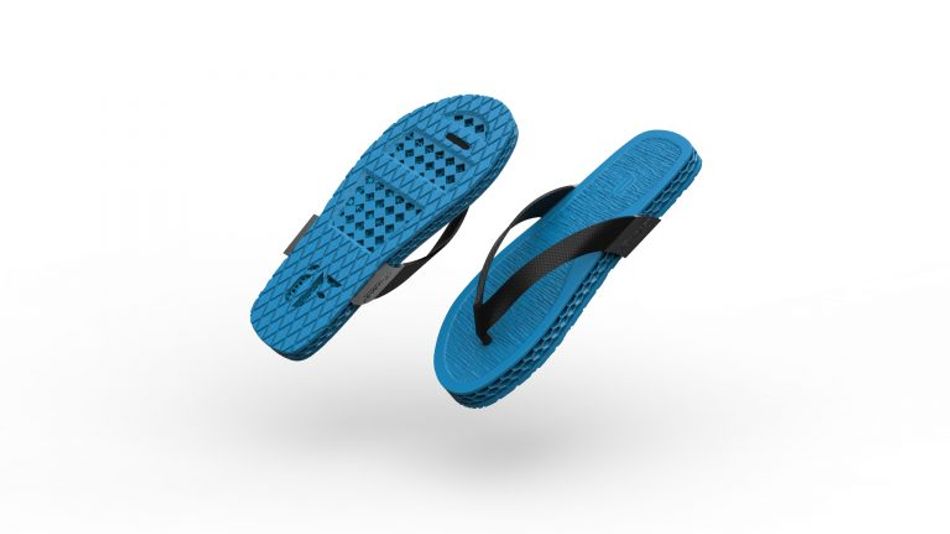Custom Latticed-Based Flip Flops for Consumers
Creating an automated design workflow for custom flip flops opens the doors for sustainability and customization in footwear.

Impact F1 Flip Flop
This article was first published on
ntopology.comChanging the way footwear is made is a pretty lofty endeavor. For decades, footwear, specifically flip flop sandals have been made the same way. A design is created and from there, molds are made of the design for various sizes of the shoe. Those molds are usually injected with a rubber-based material in a foreign factory. A process that inherently dictates that many items must be produced in order to amortize the cost of the mold, creating excessive inventory and a lack of innovation. This process, with its limitations and highly concentrated production overseas, has been what sandal production has looked like. Definitely not custom and certainly not environmentally friendly.
So, what happens when you want to make sandals locally at a 3D facility (not a footwear factory), with lattice-based structures and customer selected variations? Well, that is what I set out to do at Impact Footwear in 2019 attempting something that had not been accomplished before. I knew several key elements were going to be part of the design requirements for this shoe. The first being lattice-based structures. I had seen several performance shoes come out that used a standard lattice-based midsole. It was a good first step in using lattice structures and 3D in footwear, but I felt it missed the target on the potential of what custom 3D printed footwear could bring. Having the ability to customize a lattice structure based on mechanical testing of compression would be a great opportunity to harness this capability. Allowing the customer to select their level of compression and customizing a shoe would be a game-changer in the way footwear is made.

I set out to build an end-to-end mechanism to allow for a fully customized 3D printed sandal. I knew that for this to scale, it would need to be fully automated with no human intervention in the creation of the STL files. An end-to-end 3D experience where the customer would design their own shoe and minutes later that come to life in the form of a printed file. I needed a software partner that could help in both the design of the shoe, the lattice structures of the shoe, the automation needed to do this without human intervention, and the ability to output the necessary meshes customized to a set of individually defined requirements. That solution was nTopology.
The concept was built on the principle that you could transform a non-customized set of parts and apply the customizations using the power of nTop Platform. It starts with identifying the variables needed to do this and a mechanism to capture these data points. This is done via a 3D Web Customization tool that gives the individual the power to custom design their shoe. When you calculate the total number of variables, you end up with millions of possible configurations. This level of customization has been extremely difficult to accomplish and would not be possible in traditional footwear manufacturing of rubber sandals.
nTop Platform accomplishes this. Not only can it be done, but it can also do all of these customizations in a single notebook file providing a high level of future flexibility as modifications come about. Applying textures, selecting lattice structures and applying them to parts, adjusting variable based sizing, labeling, combining all parts to Boolean as one mesh, and outputting the necessary file for print were all capabilities needed and provided by nTop Platform. This processed through an integration layer that did not require human intervention and that could scale through a multi-threaded approach and was exactly what was needed to bring about the ability to transform footwear.
I don’t think the creators of the software believed they were building a solution for custom footwear (I was called the “crazy flip flop guy”), but that is exactly what they had invented. It makes sense as they were building a solution that could work for production capabilities and not just for creating a prototype to test. This is what much of the 3D world had been utilized for, one-off prototypes that can speed up the ability to manufacture using traditional methods. The power of 3D printing lies in customization and the automation that supports the generation of custom-based products. When software, design, automation, and 3D manufacturing are brought together, it allows for the unthinkable in the past to become a reality. What lies ahead is a great possibility and opportunity to change what we expect of the products we purchase and the level of detail that goes into them. The future of creating for need instead of for mass inventory and sell off will bring about positive change in the way we consume products and our expectations for what we purchase. We are in the early stages of this shifted mindset and I am excited to help lead the way in this transformation.
This article was first published on the nTopology blog.